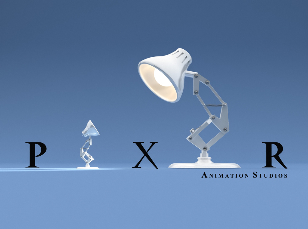 When Disney purchased Pixar Animation in 2006 for $7.4 billion and brought Pixar’s leadership into their own inner sanctum, installing John Lasseter as Principal Creative Advisor of Disney Imagineering as well as Chief Creative Officer of Pixar, it signaled not only the end of one era for Disney, but also the recognition that here was Disney’s future.
When Disney purchased Pixar Animation in 2006 for $7.4 billion and brought Pixar’s leadership into their own inner sanctum, installing John Lasseter as Principal Creative Advisor of Disney Imagineering as well as Chief Creative Officer of Pixar, it signaled not only the end of one era for Disney, but also the recognition that here was Disney’s future.
Pixar’s six films to that point had provided state-of-the-art computer-generated animation with multiple technological innovations. But even more importantly, its collegial stable of writer/directors had excelled in telling fully engaging stories.
Their tales about fish, bugs, toys, washed-up super-heroes, and monsters resonated with children and parents alike. Viewers, whether young or old, simply cared about Woody and Nemo. They related to their struggles and rooted for their successes. Audiences began to recognize that the release of a Pixar movie was an event – something not to be missed at the local Cineplex.
Animation is currently experiencing a renaissance – Sony Animation had the hit Cloudy with a Chance of Meatballs (2009); DreamWorks has had a string of hits, Shrek (2001), How to Train Your Dragon (2010); Twentieth Century Fox brought out Fantastic Mr. Fox (2009). Even Disney Studios itself is rejuvenating – Tangled (2010).
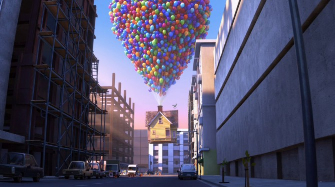 But Pixar stands alone in its storytelling genius. As Robert Velande comments in his engagingly written The Wisdom of Pixar (IVP, 2010), “Pixar films offer hope, imagination, beauty and a degree of purity and innocence that is counter-cultural in our age.” But “counter-cultural” though it is, Pixar movies continue to fully engage us as viewers. Each new movie is a worldwide cultural event, eagerly awaited and appreciatively responded to. In fact, Pixar’s eleven movies to date have yet to produce a “miss.”
But Pixar stands alone in its storytelling genius. As Robert Velande comments in his engagingly written The Wisdom of Pixar (IVP, 2010), “Pixar films offer hope, imagination, beauty and a degree of purity and innocence that is counter-cultural in our age.” But “counter-cultural” though it is, Pixar movies continue to fully engage us as viewers. Each new movie is a worldwide cultural event, eagerly awaited and appreciatively responded to. In fact, Pixar’s eleven movies to date have yet to produce a “miss.”
In earlier columns, I have highlighted the movies of Robert Duvall – some actors choose and are chosen for a body of films that make any new film they appear in a “must-see.” I also highlighted the films of Joel and Ethan Coen – some filmmakers are “auteurs” of the highest order, artists whose storytelling through word, image, and music help viewers see aspects of reality (even Reality) we would otherwise miss.
But as one evaluates what movies to see, it is not only “stars” and “auteurs” that provide selection criteria; we must also add “studios.” In particular, there is at least one studio – Pixar – whose brand is synonymous with excellence. Recall several of Pixar’s recent movies — Cars (2006), Ratatouille (2007), Wall-E (2008), and Up (2009). All are destined to become family classics on the order of Bambi, Beauty and the Beast, and The Lion King. Their DVD’s will be shown fifty years from now by grandparents to their grand kids.
In this and the next several columns, I will highlight Pixar by focusing on each of their senior creative team, on the creators of stories that have brought hope to so many of us. John Lasseter, Brad Bird, Andrew Stanton, Pete Doctor and Bob Peterson – Pixar’s stable of creative genius is as close to a sure thing as Hollywood currently has.
John Lasseter’s Cars (2006)
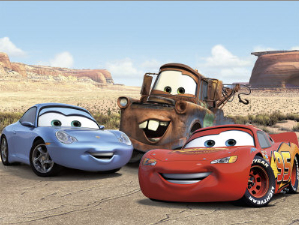 What is it about guys and cars? My wife’s father had a ’62 Volkswagen bug he loved so much that he made her family of five cram into it for one family vacation. When Cathy’s brother was a teenager, he fell in love with their mom’s used ’68 Chevrolet Impala. And by the time Jim had graduated from high school in the late 70’s he had “housed” a whole showroom of old cars on their driveway. All were junkers that Cathy’s brother lovingly and painstakingly nursed back to health and beauty — a ’34 Ford Coupe, a ’61 Chevrolet Belair, a ’64 Pontiac GTO and in particular, a ’49 Chrysler New Yorker which he still has.
What is it about guys and cars? My wife’s father had a ’62 Volkswagen bug he loved so much that he made her family of five cram into it for one family vacation. When Cathy’s brother was a teenager, he fell in love with their mom’s used ’68 Chevrolet Impala. And by the time Jim had graduated from high school in the late 70’s he had “housed” a whole showroom of old cars on their driveway. All were junkers that Cathy’s brother lovingly and painstakingly nursed back to health and beauty — a ’34 Ford Coupe, a ’61 Chevrolet Belair, a ’64 Pontiac GTO and in particular, a ’49 Chrysler New Yorker which he still has.
Not all Cathy’s neighbors were as thrilled with the cars as her brother, but her parents didn’t mind. They knew that through these cars her brother was not only learning a skill (to this day most of the family calls Jim to fix anything mechanical or electrical); he was learning what it meant to be disciplined and committed to an ongoing project. He learned to save money in order to buy parts; and he learned to ask others for help.
Older mechanics from the service station where my brother worked in the summers would give him ideas of how to fix his cars, or pass by the house to take a look at his work. Those cars were more than old vehicles, though they did help him take a journey.
Something similar happened when John Lasseter teamed with Joe Ranft and a host of other talented animators to create the movie Cars. This “car”-toon is much more than a movie for kids, as all Pixar fans know. Like all of the Pixar films, it combines artful state-of-the-art animation with a great story, clever humor, and life lessons.
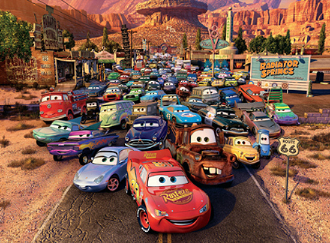 Some have called Cars Pixar’s greatest achievement, while others have considered it their worst effort (but even those critics admit that every other animation studio only wishes they could make such a “clunker”). But $5 billion in merchandising sales alone since Cars came out five years ago, and a growing enthusiasm for Cars 2 which will was released this summer suggest that Lasseter’s quirky story about a menagerie of cars has already proven an endearing addition to the animation lexicon.
Some have called Cars Pixar’s greatest achievement, while others have considered it their worst effort (but even those critics admit that every other animation studio only wishes they could make such a “clunker”). But $5 billion in merchandising sales alone since Cars came out five years ago, and a growing enthusiasm for Cars 2 which will was released this summer suggest that Lasseter’s quirky story about a menagerie of cars has already proven an endearing addition to the animation lexicon.
Like all of Pixar movies, the film has caused viewers to stop and consider their own lives, offering along the route some very important correctives to life in the “fast lane.” You see, Lightning McQueen (voiced by Owen Wilson) is a self-absorbed, rookie racing car who can only think of winning the Piston Cup Championship. He’s so enamored with his own abilities he won’t listen to others, let alone work with them to accomplish his goal.
Experienced winning race cars try to tell him that there is more to racing than winning, but he’s not interested. As he drives across country to the championship race he gets lost and winds up in the small town of Radiator Springs. There he’s arrested for speeding by the Sheriff—a 1949 Mercury Police Cruiser (voiced by Michael Wallis) and sentenced to community service by Doc Hudson, a 1951 Hudson Hornet (voiced by Paul Newman).
He must use all his horsepower to pull an asphalt machine that will repave the main street of the town. Lightning can’t believe he’s stuck with a bunch of has-beens when he should be preparing himself for his big race (and eventual stardom!).
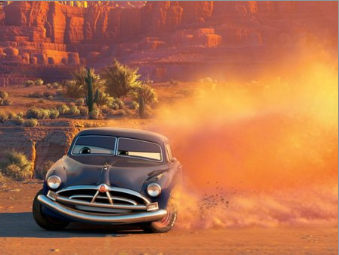 Little does Lightning know, but this sojourn among some past-their-prime cars will actually prepare him well, not only for the race, but for life. Doc Hudson teaches him to “steer left to go right” when he’s approaching the curves of any track. Sally Carrera, a 2002 Porsche 911 (voiced by Bonnie Hunt) tells him that her life turned around when she broke down in Radiator Springs and realized, “You have to be broken to be fixed.”
Little does Lightning know, but this sojourn among some past-their-prime cars will actually prepare him well, not only for the race, but for life. Doc Hudson teaches him to “steer left to go right” when he’s approaching the curves of any track. Sally Carrera, a 2002 Porsche 911 (voiced by Bonnie Hunt) tells him that her life turned around when she broke down in Radiator Springs and realized, “You have to be broken to be fixed.”
Or Mater, the tow truck (voiced by Larry the Cable Guy) teaches Lighting how to tip dozing tractors, drive backwards, go slow, and to have a best friend. A host of others: a 1959 Impala (Cheech Marin), an Italian Fiat (Tony Shalhoub), a hippie 1960 VW bus (George Carlin), a World War II jeep (Paul Dooley) and Flo, a 1950’s model with attitude (Jenifer Lewis) soon become Lightning’s family, rust and all. In getting “lost” Lightening is found as he learns to care about others.
While Lightning is on this “road trip”, viewers are also encouraged to reflect on the pace of their own lives. At one point Sally shows Lightning the open roads outside of town. She encourages him to go slow and enjoy the scenery.
Lamenting the fact that Radiator Springs and its surrounding beauty is missed by most people because the interstate highway bypassed the town, she says, “Forty years ago, it wasn’t about making great time, it was about having a great time…. The road moved through the land; it didn’t cut through it.”
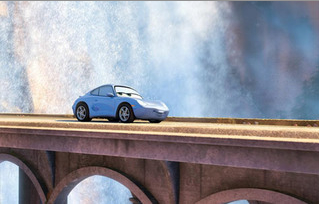 Given our competitive (The Apprentice, Survivor) and hectic (iPhones, fast-food, and high-speed internet) world, Cars challenges us to “slow down” or maybe even “pull off” to appreciate each other and God’s creation. As my wife watched the movie with me, she recalled the words of the medieval philosopher Anselm of Canterbury as he beckoned us all to rest in the Creator:
Given our competitive (The Apprentice, Survivor) and hectic (iPhones, fast-food, and high-speed internet) world, Cars challenges us to “slow down” or maybe even “pull off” to appreciate each other and God’s creation. As my wife watched the movie with me, she recalled the words of the medieval philosopher Anselm of Canterbury as he beckoned us all to rest in the Creator:
“Come now, turn aside. Turn aside for a while from your daily employment, escape for a moment from the tumult of your thoughts. Put aside your weighty cares, let your burdensome distractions wait, free yourself awhile for God, and rest awhile in Him.”
We both needed to see such reminders and to hear such words – we still do. Thus, we await eagerly Cars2 this summer – we await first rate animation, good stories, great music, clever humor, and perhaps most of all, new lessons from life that we can take to heart.

